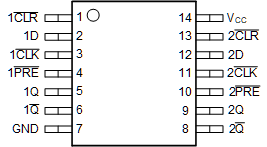SCLS801A February 2020 – June 2020 SN74HCS72
PRODUCTION DATA.
- 1 Features
- 2 Applications
- 3 Description
- 4 Revision History
- 5 Pin Configuration and Functions
- 6 Specifications
- 7 Parameter Measurement Information
- 8 Detailed Description
- 9 Application and Implementation
- 10Power Supply Recommendations
- 11Layout
- 12Device and Documentation Support
- 13Mechanical, Packaging, and Orderable Information
Package Options
Mechanical Data (Package|Pins)
Thermal pad, mechanical data (Package|Pins)
Orderable Information
5 Pin Configuration and Functions
D and PW Package
14-Pin SOIC and TSSOP
Top View

Pin Functions
| PIN | TYPE | DESCRIPTION | |
|---|---|---|---|
| NAME | NO. | ||
| 1CLR | 1 | Input | Clear for channel 1, active low |
| 1D | 2 | Input | Data for channel 1 |
| 1CLK | 3 | Input | Clock for channel 1, falling edge triggered |
| 1PRE | 4 | Input | Preset for channel 1, active low |
| 1Q | 5 | Output | Output for channel 1 |
| 1Q | 6 | Output | Inverted output for channel 1 |
| GND | 7 | — | Ground |
| 2Q | 8 | Output | Inverted output for channel 2 |
| 2Q | 9 | Output | Output for channel 2 |
| 2PRE | 10 | Input | Preset for channel 2, active low |
| 2CLK | 11 | Input | Clock for channel 2, falling edge triggered |
| 2D | 12 | Input | Data for channel 2 |
| 2CLR | 13 | Input | Clear for channel 2, active low |
| VCC | 14 | — | Positive supply |